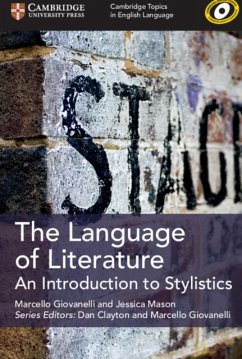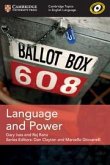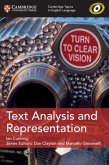- Broschiertes Buch
- Merkliste
- Auf die Merkliste
- Bewerten Bewerten
- Teilen
- Produkt teilen
- Produkterinnerung
- Produkterinnerung
Essential study guides for the future linguist.
Andere Kunden interessierten sich auch für
![Cambridge Topics in English Language Narrative Cambridge Topics in English Language Narrative]() Marcello GiovanelliCambridge Topics in English Language Narrative30,99 €
Marcello GiovanelliCambridge Topics in English Language Narrative30,99 €![Cambridge Topics in English Language Attitudes to Language Cambridge Topics in English Language Attitudes to Language]() Dan ClaytonCambridge Topics in English Language Attitudes to Language30,99 €
Dan ClaytonCambridge Topics in English Language Attitudes to Language30,99 €![Cambridge Topics in English Language Language Diversity and World Englishes Cambridge Topics in English Language Language Diversity and World Englishes]() Dan ClaytonCambridge Topics in English Language Language Diversity and World Englishes30,99 €
Dan ClaytonCambridge Topics in English Language Language Diversity and World Englishes30,99 €![Cambridge Topics in English Language Language and Gender Cambridge Topics in English Language Language and Gender]() Felicity TitjenCambridge Topics in English Language Language and Gender30,99 €
Felicity TitjenCambridge Topics in English Language Language and Gender30,99 €![Cambridge Topics in English Language Language and Power Cambridge Topics in English Language Language and Power]() Gary IvesCambridge Topics in English Language Language and Power30,99 €
Gary IvesCambridge Topics in English Language Language and Power30,99 €![Cambridge Topics in English Language Language Development Cambridge Topics in English Language Language Development]() Rachel RudmanCambridge Topics in English Language Language Development29,99 €
Rachel RudmanCambridge Topics in English Language Language Development29,99 €![Cambridge Topics in English Language Text Analysis and Representation Cambridge Topics in English Language Text Analysis and Representation]() Ian CushingCambridge Topics in English Language Text Analysis and Representation30,99 €
Ian CushingCambridge Topics in English Language Text Analysis and Representation30,99 €-
-
-
Produktdetails
- Produktdetails
- Cambridge Topics in English Language
- Verlag: Cambridge University Press
- Seitenzahl: 134
- Erscheinungstermin: 25. Januar 2018
- Englisch
- Abmessung: 155mm x 229mm x 7mm
- Gewicht: 212g
- ISBN-13: 9781108402217
- ISBN-10: 1108402216
- Artikelnr.: 48916753
- Herstellerkennzeichnung
- Libri GmbH
- Europaallee 1
- 36244 Bad Hersfeld
- gpsr@libri.de
- Cambridge Topics in English Language
- Verlag: Cambridge University Press
- Seitenzahl: 134
- Erscheinungstermin: 25. Januar 2018
- Englisch
- Abmessung: 155mm x 229mm x 7mm
- Gewicht: 212g
- ISBN-13: 9781108402217
- ISBN-10: 1108402216
- Artikelnr.: 48916753
- Herstellerkennzeichnung
- Libri GmbH
- Europaallee 1
- 36244 Bad Hersfeld
- gpsr@libri.de
1. What is stylistics?: 1.1. Introduction
1.2. Defining stylistics
1.3. Why stylistics?
1.4. Principles of stylistics
2. Developing a stylistics toolkit: 2.1. Introduction
2.2. Foregrounding
2.3. Using levels of language analysis
2.4. Words
2.5. Structure
2.6. Sounds
2.7. Developing writing as a response
3. Doing stylistics: 3.1. Introduction
3.2. Speech and thought presentation
3.3. Modality
3.4. Transitivity
3.5. Deixis and viewpoint
4. Stylistics and the mind: 4.1. Introduction
4.2. Figure and ground
4.3. Schema theory
4.4. Metaphor
4.5. Text World Theory
5. Exploring stylistics: 5.1. Introduction
5.2. Creative writing and stylistics
5.3. Reader response studies and stylistics
5.4. Corpus stylistics
Ideas and answers
References.
1.2. Defining stylistics
1.3. Why stylistics?
1.4. Principles of stylistics
2. Developing a stylistics toolkit: 2.1. Introduction
2.2. Foregrounding
2.3. Using levels of language analysis
2.4. Words
2.5. Structure
2.6. Sounds
2.7. Developing writing as a response
3. Doing stylistics: 3.1. Introduction
3.2. Speech and thought presentation
3.3. Modality
3.4. Transitivity
3.5. Deixis and viewpoint
4. Stylistics and the mind: 4.1. Introduction
4.2. Figure and ground
4.3. Schema theory
4.4. Metaphor
4.5. Text World Theory
5. Exploring stylistics: 5.1. Introduction
5.2. Creative writing and stylistics
5.3. Reader response studies and stylistics
5.4. Corpus stylistics
Ideas and answers
References.
1. What is stylistics?: 1.1. Introduction
1.2. Defining stylistics
1.3. Why stylistics?
1.4. Principles of stylistics
2. Developing a stylistics toolkit: 2.1. Introduction
2.2. Foregrounding
2.3. Using levels of language analysis
2.4. Words
2.5. Structure
2.6. Sounds
2.7. Developing writing as a response
3. Doing stylistics: 3.1. Introduction
3.2. Speech and thought presentation
3.3. Modality
3.4. Transitivity
3.5. Deixis and viewpoint
4. Stylistics and the mind: 4.1. Introduction
4.2. Figure and ground
4.3. Schema theory
4.4. Metaphor
4.5. Text World Theory
5. Exploring stylistics: 5.1. Introduction
5.2. Creative writing and stylistics
5.3. Reader response studies and stylistics
5.4. Corpus stylistics
Ideas and answers
References.
1.2. Defining stylistics
1.3. Why stylistics?
1.4. Principles of stylistics
2. Developing a stylistics toolkit: 2.1. Introduction
2.2. Foregrounding
2.3. Using levels of language analysis
2.4. Words
2.5. Structure
2.6. Sounds
2.7. Developing writing as a response
3. Doing stylistics: 3.1. Introduction
3.2. Speech and thought presentation
3.3. Modality
3.4. Transitivity
3.5. Deixis and viewpoint
4. Stylistics and the mind: 4.1. Introduction
4.2. Figure and ground
4.3. Schema theory
4.4. Metaphor
4.5. Text World Theory
5. Exploring stylistics: 5.1. Introduction
5.2. Creative writing and stylistics
5.3. Reader response studies and stylistics
5.4. Corpus stylistics
Ideas and answers
References.








